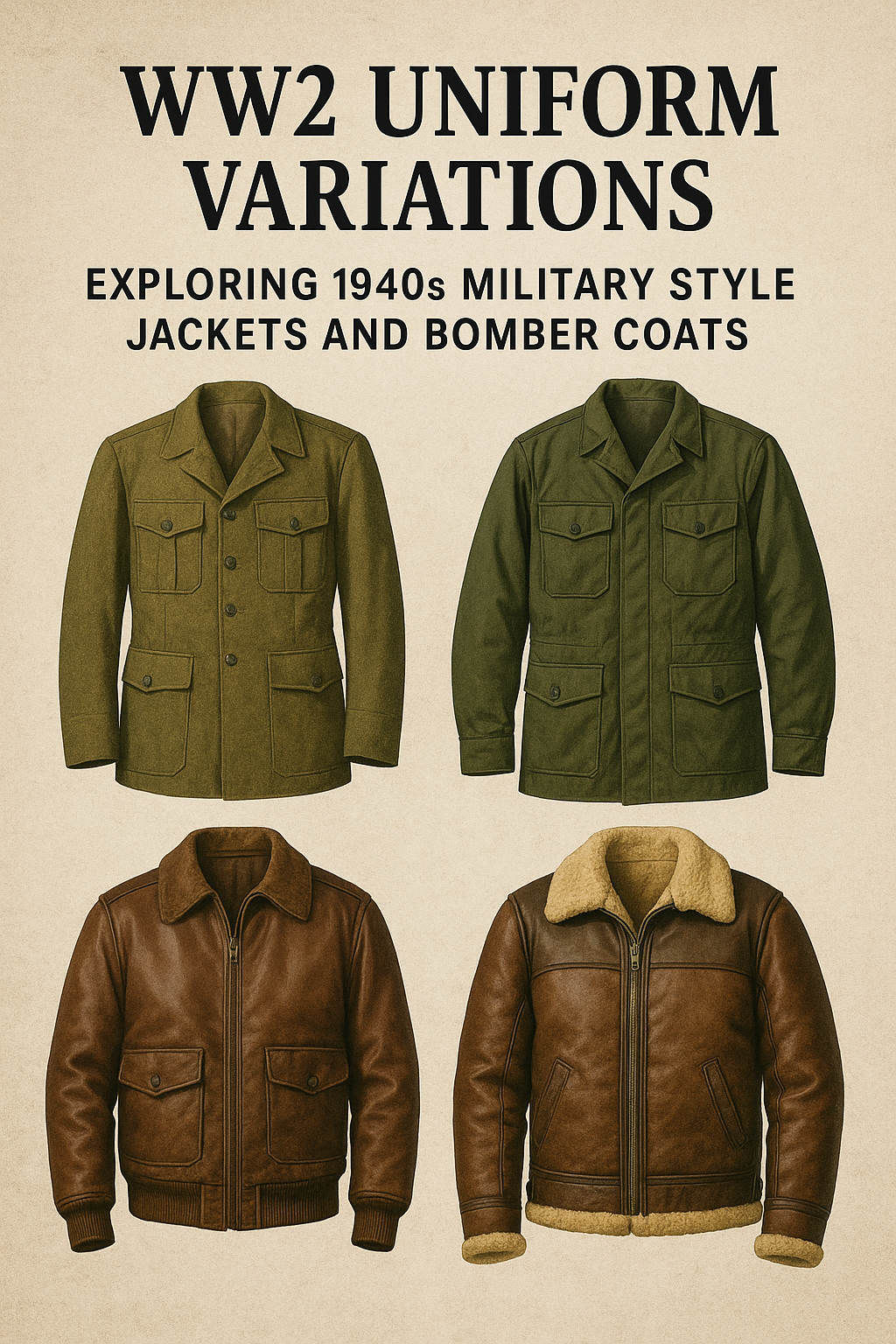
WW2 Uniform Variations: Exploring 1940s Military Style Jackets and Bomber Coats
Published on May 05, 2025
WW2 Uniform Variations: The Iconic Military Jackets That Shaped History and Style
Introduction: More Than Just Fabric—WW2 Uniforms Defined an Era
The Second World War (1939–1945) was a time of immense change, not only in geopolitics but also in military innovation. One often overlooked area is the evolution of the WW2 military uniform, which went far beyond functionality. The WW2 uniform variations that emerged during this era reflected the needs of different environments, military branches, and global influences. Today, collectors, history buffs, and fashion enthusiasts look back at these 1940s military-style jackets as emblems of durability, identity, and timeless style.
Let’s explore how various types of WW2 jackets—like the army coat, 1940 bomber jacket, and the 1940s flight jacket—came to define the look and functionality of the Allied forces.
1. The Foundation: WW2 Army Coats and Their Role in Combat
One of the most recognizable WW2 uniform pieces is the WW2 army coat. These coats were designed to provide warmth, protection, and adaptability in harsh conditions.
Key Features of WW2 Army Coats:
- Made from heavy wool or cotton canvas
- Designed to be layered for extreme weather
- Typically olive drab or khaki
- Included large buttoned pockets and epaulettes
Variations by Region:
- U.S. M1943 Field Jacket: Introduced in 1943, this coat offered improved versatility with a layered system.
- British Battledress: A shorter wool jacket with matching trousers made for rapid movement and combat agility.
- German M36 Tunic: Known for its tailored fit and dark green color, this coat was both functional and sharply designed.
2. The Rise of the 1940s Flight Jacket: Style Born in the Skies
Few garments from WW2 have left as lasting a legacy as the 1940s flight jacket. Developed for bomber crews and pilots, these jackets had to withstand high-altitude freezing temperatures and remain maneuverable in cramped cockpits.
Famous WW2 Flight Jackets:
- A-2 Flight Jacket (U.S.): Made from horsehide or goatskin leather with a warm wool lining. Known for its ribbed cuffs and waistband.
- B-3 Bomber Jacket: Designed for cold-weather missions, this sheepskin jacket featured shearling lining and leather exteriors—instantly recognizable and incredibly warm.
- RAF Irvin Flying Jacket (UK): Used by the Royal Air Force, this jacket became iconic for its brown leather and cream sheepskin interior.
Legacy and Fashion Influence:
The 1940s flight jacket became a staple of the post-war style. From Hollywood stars to punk fashion, the rugged and masculine look of these jackets continues to influence outerwear collections today.
3. The 1940 Bomber Jacket: Function Meets Flair
Closely related to the flight jacket, the 1940 bomber jacket was another critical evolution in military outerwear. Originally designed for U.S. Army Air Forces bomber crews, the jacket was light, warm, and wind-resistant.
Defining Characteristics of Bomber Jackets:
- Short waist length for comfort during flight
- Fleece or wool linings
- Zippered front with snap-flap pockets
- Ribbed cuffs, collar, and waistband for insulation
Material Innovation:
While early models were leather, fabric versions like the B-10 and B-15 used cotton or nylon with synthetic fur collars to reduce bulk and cost. These jackets paved the way for the modern MA-1 bomber jacket, which is still popular today.
4. Military Style Jackets Beyond the Battlefield
After the war, surplus WW2 jackets flooded the civilian market. What was once a military issue became civilian fashion. Veterans wore their service coats proudly, and others adopted the look for its utility and style.
Why WW2 Jackets Still Matter:
- Durability: Built to last in combat, they still hold up today.
- Versatility: Easy to style with both vintage and modern outfits.
- Symbolism: Wearing a WW2 jacket can feel like wearing history.
From runway collections to streetwear brands, modern designers still reference WW2 uniform variations in their creations, proving that classic never goes out of style.
5. Choosing the Right WW2 Jacket for Your Collection
Whether you’re a collector, a reenactor, or simply someone who appreciates vintage craftsmanship, knowing the difference between a 1940s flight jacket, army coat, and 1940 bomber jacket can help you choose the right piece.
Tips for Buyers:
- Look for authentic details like military labels, stitching, and original buttons.
- Consider replicas from reputable vendors like Paddelaters.com for high-quality, historically accurate options.
- Protect your investment by storing your jacket in cool, dry places.
Conclusion: WW2 Uniform Variations Tell a Story of Strength and Style
From the trenches of Europe to the cockpits above the Pacific, WW2 uniform variations reflect the resilience, innovation, and enduring influence of the men and women who wore them. The WW2 army coat, 1940s flight jacket, and 1940 bomber jacket each played a unique role in military history—and today, they continue to inspire and captivate.
